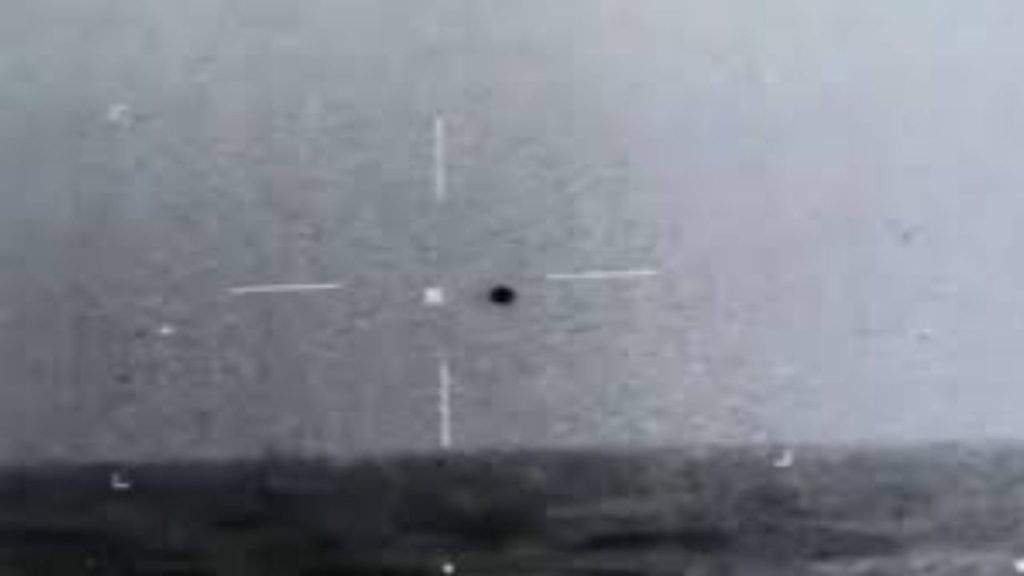Transmedium vehicles can easily travel in between space, the Earth’s atmosphere, and water.
Often, UAP has been seen moving quickly and easily in and between different environments, such as space, the Earth’s atmosphere, and water.
In the Nimitz incident, witnesses described a UFO hovering over a churning “disturbance” just under the ocean’s otherwise calm surface, leading to speculation that another craft had entered the water.
USS Princeton radar operator Gary Vorhees later confirmed from a Navy sonar operator in the area that day that a craft was moving faster than 70 knots, roughly two times the speed of nuclear subs.
According to Lue Elizondo, certain things distinguish alien technology from earthly ones. Five different observables set this technology.
One of these features is transmedium characteristics. It means the ability for an object to fly in our atmosphere, at low and high altitudes, and in a vacuum environment like space and even underwater.
For example, a seaplane is a plane that can fly, and it can also float on the water.
But when you look at it, it’s neither a very good aircraft nor a boat because it’s a design compromise. Yet what we are seeing is UAPs that can operate in all these domains or all these environments, seemingly without any performance compromise.
We see these UFOs around in and around water. They’ve been recorded in our atmosphere, and data suggest that they’ve also been tracked by some of our capabilities underwater and performed in ways that exceed anything we know about.

Examples of military transmedium vehicles
- The Reid Flying Submarine (RFS-1)
- Lockheed Martin Cormorant (Wikipedia)
- Ushakov LPL Flying Submarine (1934 the project was abandoned later)
- Convair “Subplane” (cancelled)
The Navy had trans medium vehicles like flying submersibles a decade ago. These crafts were intended to provide stealthy transport for Special Forces units into and out of operating areas.
It wasn’t the first study of its kind to propose such a “transmedium” vehicle, defined as capable of use in multiple domains, such as in the air and underwater.
It’s not clear how far the military complex attempts went, but the document’s conclusions are significant because they note that over a decade ago.
Also, transmedium aircraft that could operate under the sea have long been pursued by the U.S. Navy and other militaries.
They have tried to build a transmedium vehicle since at least the 50s, including different forms of submersible aircraft to more contemporary designs like the short-lived Lockheed Martin Cormorant.

The “Holy Grail” of transmedium vehicle
Among the “holy grails” of military research is a truly hybrid vehicle, a flying submarine that can travel effortlessly between the sky and the sea.
They wanted to build a transmedium vehicle with the speed and range of an aircraft with the stealth of a submarine by developing a transmedium vehicle that could both fly and submerge.
The ultimate goal was to develop a transmedium vehicle that could insert and extract Special Forces units at greater ranges and speeds than existing platforms.
However, the technological gap between producing a vehicle that can transition between the surface and under the water of the oceans and creating a true flying submarine is unquestionably massive.
In addition to Department of Defense (DoD)-funded laboratories, there has been a demonstrated interest in multi-medium vehicles by the military-industrial complex.
Furthermore, large aerospace contractors possess patents for transmedium vehicles, such as the low-key name “Vehicle” patent assigned to Lockheed Martin.

The “Vehicle” transmedium patent details a turbofan-powered transmedium vertical take-off and landing craft able to travel on the water, vertical flight, and hovercraft-type operation.
Moreover, one of the primary purposes of the patent was to provide a VTOL vehicle capable of traveling long distances over the water.
And like so many other transmedium vehicle projects, it’s unclear just how far these projects went.
But so far, there is no evidence that the decades-long search for a hybrid aerospace-underwater “flying submarine” vehicle has resulted in anything but a trove of conceptual studies hidden away in academic literature and a handful of UUV/UAV concepts that have shown promise in testing.
The fact that military studies concluded over a decade ago that an idea with transmedium vehicles is possible within the current state of the art shows just how close we may be to seeing the dream of a flying submarine realized.
Such a transmedium vehicle would be far more relevant now than in the last decades.
A transmedium low-flying, somewhat low-observable craft could convey special operators through defended airspace and then deliver them into downright enemy territory while submerged.
It wouldn’t be outside the realm of the possibility that a concept like this could exist in a secret operational state today.
